Zircon U-Pb-Hf Isotopes and Whole-Rock Geochemistry of the “Kulumudi Formation” from the Laofengkou Area (West Junggar): Implications of the Construction of a Juvenile Arc in the Junggar–Balkhash Ocean
Abstract
:1. Introduction
2. Geological Setting and Sampling
2.1. Tectonic Units of the WJT
2.2. Geology of the Study Area
2.3. Sample Description
3. Analytical Methods
3.1. Zircon U-Pb and Lu-Hf Isotope Analysis
3.2. Whole-Rock Major and Trace Element Analysis
4. Analytical Results
4.1. Zircon U-Pb and Lu-Hf Isotope Analysis
4.1.1. Zircon U-Pb Ages
4.1.2. Hf Isotopes
4.2. Whole-Rock Major and Trace Element Analysis
4.2.1. Major Elements
4.2.2. Trace Elements
5. Discussion
5.1. Sedimentary Age of the Kulumudi Formation
5.2. Tectonic Setting
5.2.1. The Middle Devonian Kulumudi Formation
5.2.2. The Early Carboniferous Jiangbasitao Formation
5.3. Tectonic Evolution of West Junggar during the Middle Devonian–Early Carboniferous
6. Conclusions
- (1)
- The lithic crystal tuff from the Kulumudi Formation northeast of the Alemale Mountains in the Laofengkou area yielded a zircon U-Pb age of 386 ± 2 Ma and was formed during the Middle Devonian. The maximum depositional age for the fine sandstone originally assigned into the “Kulumudi Formation” southwest of the Huojierte Mongolian Township was 341 ± 3 Ma, belonging to the Lower Carboniferous Jiangbasitao Formation.
- (2)
- According to the whole-rock geochemistry and Hf isotope analysis, the Middle Devonian Kulumudi Formation and Lower Carboniferous Jiangbasitao Formation formed in a juvenile arc setting related to the ocean–continent subduction.
- (3)
- During the Middle Devonian to Early Carboniferous, the ocean basin represented by the Darbut–Karamay ophiolitic mélanges subducted southward beneath the newly accreted arc crustal segments, forming a juvenile arc with positive Hf isotopic characteristics.
Supplementary Materials
Author Contributions
Funding
Data Availability Statement
Acknowledgments
Conflicts of Interest
References
- Şengör, A.M.C.; Natal’in, B.A.; Burtman, V.S. Evolution of the Altaid tectonic collage and Palaeozoic crustal growth in Eurasia. Nature 1993, 364, 299–307. [Google Scholar] [CrossRef]
- Windley, B.F.; Alexeiev, D.; Xiao, W.J.; Kröner, A.; Badarch, G. Tectonic models for accretion of the Central Asian Orogenic Belt. J. Geol. Soc. 2007, 164, 31–47. [Google Scholar] [CrossRef]
- Kröner, A.; Hegner, E.; Lehmann, B.; Heinhorst, J.; Wingate, M.T.D.; Liu, D.Y.; Ermelov, P. Palaeozoic arc magmatism in the Central Asian Orogenic Belt of Kazakhstan: SHRIMP zircon ages and whole-rock Nd isotopic systematics. J. Asian Earth Sci. 2008, 32, 118–130. [Google Scholar] [CrossRef]
- Li, P.; Sun, M.; Rosenbaum, G.; Yuan, C.; Safonova, I.; Cai, K.; Jiang, Y.; Zhang, Y. Geometry, kinematics and tectonic models of the Kazakhstan Orocline, Central Asian Orogenic Belt. J. Asian Earth Sci. 2018, 153, 42–56. [Google Scholar] [CrossRef]
- Xiao, W.; Windley, B.F.; Sun, S.; Li, J.; Huang, B.; Han, C.; Yuan, C.; Sun, M.; Chen, H. A Tale of Amalgamation of Three Permo-Triassic Collage Systems in Central Asia: Oroclines, Sutures, and Terminal Accretion. Annu. Rev. Earth Planet. Sci. 2015, 43, 477–507. [Google Scholar] [CrossRef]
- Liu, Y.; Xiao, W.; Ma, Y.; Li, S.; Peskov, A.Y.; Chen, Z.; Zhou, T.; Guan, Q. Oroclines in the Central Asian Orogenic Belt. Natl. Sci. Rev. 2023, 10, nwac243. [Google Scholar] [CrossRef]
- Xiao, W.; Han, C.; Yuan, C.; Sun, M.; Lin, S.; Chen, H.; Li, Z.; Li, J.; Sun, S. Middle Cambrian to Permian subduction-related accretionary orogenesis of Northern Xinjiang, NW China: Implications for the tectonic evolution of central Asia. J. Asian Earth Sci. 2008, 32, 102–117. [Google Scholar] [CrossRef]
- Choulet, F.; Cluzel, D.; Faure, M.; Lin, W.; Wang, B.; Chen, Y.; Wu, F.; Ji, W. New constraints on the pre-Permian continental crust growth of Central Asia (West Junggar, China) by U-Pb and Hf isotopic data from detrital zircon: Pre-Permian continental crust growth of Central Asia. Terra Nova 2012, 24, 189–198. [Google Scholar] [CrossRef]
- Liu, B.; Han, B.F. Identification of lateral inhomogeneity of arc basement by reconstructing the Late Devonian arc belt in the southwestern Central Asian Orogenic Belt. J. Geodyn. 2019, 132, 101668. [Google Scholar] [CrossRef]
- Ren, R.; Liu, B.; Han, B.F.; Guan, S.W. Early-Middle Devonian adakitic magmatism generated by slab retreat in southern West Junggar, NW China: Implications for tectonic correlation with central and East Kazakhstan. Int. Geol. Rev. 2023, 65, 2315–2331. [Google Scholar] [CrossRef]
- Safonova, I.; Perfilova, A. Survived and disappeared intra-oceanic arcs of the Paleo-Asian Ocean: Evidence from Kazakhstan. Natl. Sci. Rev. 2023, 10, nwac215. [Google Scholar] [CrossRef] [PubMed]
- Zhang, P.; Wang, G.C.; Shen, T.; Polat, A.; Zhu, C. Paleozoic convergence processes in the southwestern Central Asian Orogenic Belt: Insights from U–Pb dating of detrital zircons from West Junggar, northwestern China. Geosci. Front. 2021, 12, 531–548. [Google Scholar] [CrossRef]
- Wu, C.; Hong, T.; Xu, X.-W.; Cao, M.-J.; Li, H.; Zhang, G.-L.; You, J.; Ke, Q.; Dong, L.-H. Tectonic evolution of the Paleozoic Barluk continental arc, West Junggar, NW China. J. Asian Earth Sci. 2018, 160, 48–66. [Google Scholar] [CrossRef]
- Han, B.F.; Guo, Z.J.; He, G.Q. Timing of major suture zones in North Xinjiang, China: Constraints from stitching plutons. Acta Petrol. Sin. 2010, 26, 2233–2246, (In Chinese with English abstract). [Google Scholar]
- Liu, B.; Han, B.F.; Xu, Z.; Ren, R.; Chen, J.F. The Ediacaran to Early Paleozoic evolution of the Junggar– Balkhash Ocean: A synthesis of the ophiolitic mélanges in the southern West Junggar terrane, NW China. Geol. J. 2020, 55, 1689–1707. [Google Scholar] [CrossRef]
- Chen, B.; Arakawa, Y. Elemental and Nd-Sr isotopic geochemistry of granitoids from the West Junggar foldbelt (NW China), with implications for Phanerozoic continental growth. Geochim. Cosmochim. Acta 2005, 69, 1307–1320. [Google Scholar] [CrossRef]
- Liu, B.; Han, B.-F.; Xu, Z.; Ren, R.; Zhang, J.-R.; Zhou, J.; Su, L.; Li, Q.-L. The Cambrian initiation of intra-oceanic subduction in the southern Paleo-Asian Ocean: Further evidence from the Barleik subduction-related metamorphic complex in the West Junggar region, NW China. J. Asian Earth Sci. 2016, 123, 1–21. [Google Scholar] [CrossRef]
- Liu, B.; Han, B.F.; Ren, R.; Chen, J.F.; Wang, Z.Z.; Zheng, B. Petrogenesis and tectonic implications of the Early Carboniferous to the Late Permian Barleik plutons in the West Junggar (NW China). Lithos 2017, 272–273, 232–248. [Google Scholar] [CrossRef]
- Xu, Z.; Han, B.-F.; Ren, R.; Zhou, Y.-Z.; Zhang, L.; Chen, J.-F.; Su, L.; Li, X.-H.; Liu, D.-Y. Ultramafic–mafic mélange, island arc and post-collisional intrusions in the Mayile Mountain, West Junggar, China: Implications for Paleozoic intra-oceanic subduction–accretion process. Lithos 2012, 132–133, 141–161. [Google Scholar] [CrossRef]
- Ren, R.; Han, B.-F.; Xu, Z.; Zhou, Y.-Z.; Liu, B.; Zhang, L.; Chen, J.-F.; Su, L.; Li, J.; Li, X.-H.; et al. When did the subduction first initiate in the southern Paleo-Asian Ocean: New constraints from a Cambrian intra-oceanic arc system in West Junggar, NW China. Earth Planet. Sci. Lett. 2014, 388, 222–236. [Google Scholar] [CrossRef]
- Liu, B.; Han, B.F.; Chen, J.F.; Ren, R.; Zheng, B.; Wang, Z.Z.; Feng, L.X. Closure time of the Junggar-Balkhash Ocean: Constraints from Late Paleozoic volcano-sedimentary sequences in the Barleik Mountains, West Junggar, NW China. Tectonics 2017, 36, 2823–2845. [Google Scholar] [CrossRef]
- Zheng, B.; Han, B.F.; Liu, B.; Wang, Z.Z. Ediacaran to Paleozoic magmatism in West Junggar Orogenic Belt, NW China, and implications for evolution of Central Asian Orogenic Belt. Lithos 2019, 338–339, 111–127. [Google Scholar] [CrossRef]
- Liao, W.; Han, B.F.; Xu, Y.; Li, A. Ediacaran initial subduction and Cambrian slab rollback of the Junggar Ocean: New evidence from igneous tectonic blocks and gabbro enclave in Early Palaeozoic accretionary complexes, southern West Junggar, NW China. Geol. Mag. 2021, 158, 1811–1829. [Google Scholar] [CrossRef]
- Chen, J.F.; Han, B.F.; Ji, J.Q.; Zhang, L.; Xu, Z.; He, G.Q.; Wang, T. Zircon U–Pb ages and tectonic implications of Paleozoic plutons in northern West Junggar, North Xinjiang, China. Lithos 2010, 115, 137–152. [Google Scholar] [CrossRef]
- Gao, R.; Xiao, L.; Pirajno, F.; Wang, G.C.; He, X.X.; Yang, G.; Yan, S.W. Carboniferous–Permian extensive magmatism in the West Junggar, Xinjiang, northwestern China: Its geochemistry, geochronology, and petrogenesis. Lithos 2014, 204, 125–143. [Google Scholar] [CrossRef]
- Han, B.F.; Ji, J.Q.; Song, B.; Chen, L.H.; Zhang, L. Late Paleozoic vertical growth of continental crust around the Junggar Basin, Xinjiang, China (part I): Timing of postcollisional plutonism. Acta Petrol. Sin. 2006, 22, 1077–1086, (In Chinese with English abstract). [Google Scholar]
- Hong, Y.B.H.; Liu, B.; Han, B.F.; Ma, J.X.; Chen, J.D. Late Carboniferous closure of the Junggar-Balkhash Ocean: Insights from the early Permian post-accretionary magmatism in the Barleik Mountains of West Junggar, NW China. Lithos 2022, 432–433, 106900. [Google Scholar] [CrossRef]
- Geng, H.; Sun, M.; Yuan, C.; Xiao, W.; Xian, W.; Zhao, G.; Zhang, L.; Wong, K.; Wu, F. Geochemical, Sr–Nd and zircon U–Pb–Hf isotopic studies of Late Carboniferous magmatism in the West Junggar, Xinjiang: Implications for ridge subduction? Chem. Geol. 2009, 266, 364–389. [Google Scholar] [CrossRef]
- Tang, G.J.; Wang, Q.; Wyman, D.A.; Li, Z.X.; Zhao, Z.H.; Jia, X.H.; Jiang, Z.Q. Ridge subduction and crustal growth in the Central Asian Orogenic Belt: Evidence from Late Carboniferous adakites and high-Mg diorites in the western Junggar region, northern Xinjiang (west China). Chem. Geol. 2010, 277, 281–300. [Google Scholar] [CrossRef]
- Zhang, J.E.; Chen, Y.C.; Xiao, W.J.; Wakabayashi, J.; Windley, B.F.; Yin, J. Sub-parallel ridge-trench interaction and an alternative model for the Silurian-Devonian archipelago in Western Junggar and North-Central Tianshan in NW China. Earth-Sci. Rev. 2021, 217, 103648. [Google Scholar] [CrossRef]
- XBGMR (Xinjiang Bureau of Geology and Mineral Resources, Xinjiang, China). Regional Geological Map of Tuoli Area (L-44-XXIV); Map Scale 1:200 000; XBGMR: Urumqi, China, 1975. (In Chinese) [Google Scholar]
- Wang, J.R.; Jia, Z.L.; Li, T.D.; Ma, J.L.; Zhao, L.; He, Y.B.; Zhang, W.; Liu, K.X. Discovery of Early Devonian adakite in West Junggar, Xinjiang: Implications for geotectonics and Cu mineralization. Acta Petrol. Sin. 2013, 29, 840–852, (In Chinese with English abstract). [Google Scholar]
- Han, B.F.; He, G.Q.; Wang, S.G. Postcollisional mantle-derived magmatism, underplating and implications for basement of the Junggar Basin. Sci. China Ser. D Earth Sci. 1999, 42, 113–119. [Google Scholar] [CrossRef]
- Zheng, B.; Han, B.F.; Wang, Z.Z.; Liu, B.; Feng, L.X. An example of Phanerozoic continental crustal growth: The West Junggar Orogenic Belt, Northwest China. Lithos 2020, 376, 105745. [Google Scholar] [CrossRef]
- Zhao, L.; He, G.Q. Geochronology and geochemistry of the Cambrian (~518 Ma) Chagantaolegai ophiolite in northern West Junggar (NW China): Constraints on spatiotemporal characteristics of the Chingiz–Tarbagatai megazone. Int. Geol. Rev. 2014, 56, 1181–1196. [Google Scholar] [CrossRef]
- Yang, Y.Q.; Zhao, L.; Zheng, R.G.; Xu, Q.Q. Evolution of the early Paleozoic Hongguleleng–Balkybey Ocean: Evidence from the Hebukesaier ophiolitic mélange in the northern West Junggar, NW China. Lithos 2019, 324–325, 519–536. [Google Scholar] [CrossRef]
- Xu, Z.; Han, B.F.; Ren, R.; Zhou, Y.Z.; Su, L. Palaeozoic multiphase magmatism at Barleik Mountain, southern West Junggar, Northwest China: Implications for tectonic evolution of the West Junggar. Int. Geol. Rev. 2013, 55, 633–656. [Google Scholar] [CrossRef]
- Yang, Y.Q.; Zhao, L.; Zhang, J.; Niu, M.L. Middle Paleozoic archipelago amalgamation and tectonic transform in the northern West Junggar, NW China: Constraints from magmatism and deformation. Gondwana Res. 2021, 98, 147–165. [Google Scholar] [CrossRef]
- Yin, J.; Chen, W.; Yuan, C.; Yu, S.; Xiao, W.; Long, X.; Li, J.; Sun, J. Petrogenesis of Early Carboniferous adakitic dikes, Sawur region, northern West Junggar, NW China: Implications for geodynamic evolution. Gondwana Res. 2015, 27, 1630–1645. [Google Scholar] [CrossRef]
- Xu, Y.; Han, B.F.; Liao, W.; Li, A. The Serpukhovian–Bashkirian Amalgamation of Laurussia and the Siberian Continent and Implications for Assembly of Pangea. Tectonics 2022, 41, e2022TC007218. [Google Scholar] [CrossRef]
- Chen, J.F.; Han, B.F.; Zhang, L.; Xu, Z.; Liu, J.L.; Qu, W.J.; Li, C.; Yang, J.H.; Yang, Y.H. Middle Paleozoic initial amalgamation and crustal growth in the West Junggar (NW China): Constraints from geochronology, geochemistry and Sr–Nd–Hf–Os isotopes of calc-alkaline and alkaline intrusions in the Xiemisitai-Saier Mountains. J. Asian Earth Sci. 2015, 113, 90–109. [Google Scholar] [CrossRef]
- Shen, P.; Shen, Y.C.; Li, X.H.; Pan, H.D.; Zhu, H.P.; Meng, L.; Dai, H.W. Northwestern Junggar Basin, Xiemisitai Mountains, China: A geochemical and geochronological approach. Lithos 2012, 140–141, 103–118. [Google Scholar] [CrossRef]
- Yin, J.Y.; Chen, W.; Xiao, W.J.; Yuan, C.; Windley, B.F.; Yu, S.; Cai, K.D. Late Silurian–early Devonian adakitic granodiorite, A-type and I-type granites in NW Junggar, NW China: Partial melting of mafic lower crust and implications for slab roll-back. Gondwana Res. 2017, 43, 55–73. [Google Scholar] [CrossRef]
- Gu, P.Y.; Li, Y.J.; Zhang, B.; Tong, L.L.; Wang, J.N. LA-ICP-MS zircon U-Pb dating of gabbro in the Darbut ophiolite, western Junggar, China. Acta Petrol. Silica 2009, 25, 1364–1372, (In Chinese with English abstract). [Google Scholar]
- Chen, S.; Guo, Z.J. Time constraints, tectonic setting of Dalabute ophiolitic complex and its significance for Late Paleozoic tectonic evolution in West Junggar. Acta Petrol. Sin. 2010, 26, 2336–2344, (In Chinese with English abstract). [Google Scholar]
- Chen, S.; Pe-Piper, G.; Piper, D.J.W.; Guo, Z. Ophiolitic mélanges in crustal-scale fault zones: Implications for the Late Palaeozoic tectonic evolution in West Junggar, China: Fault-zone ophiolite, West Junggar. Tectonics 2014, 33, 2419–2443. [Google Scholar] [CrossRef]
- Zhao, L.; He, G.Q. LA-ICP-MS zircon age of dacite in Tailegula Formation and their constraints on emplacement of darbut ophiolite in West Junggar. Acta Sci. Nat. Univ. Pekin. 2016, 52, 871–880, (In Chinese with English abstract). [Google Scholar]
- Bai, J.K.; Chen, J.L.; Tang, Z.; Zhang, Y. Redefinition of the Middle Devonian Kulumudi Formation in the south of Tiechanggou town, West Junggar, Xinjiang and its geological implications. Northwestern Geol. 2015, 48, 72–80, (In Chinese with English abstract). [Google Scholar]
- Bai, J.K.; Chen, J.L.; Yan, Z.; Tang, Z.; Xu, X.Y.; Li, J.L. The timing of opening and closure of the Mayile oceanic basin: Evidence from the angular unconformity between the Middle Devonian and its underlying geological body in the southern West Junggar. Acta Petrol. Sin. 2015, 31, 133–142, (In Chinese with English abstract). [Google Scholar]
- Xiang, K.P.; Li, Y.J.; Li, Z.; Wang, R.; Yang, G.X.; Duan, F.H.; Li, G.Y. LA ICP-MS zircon age and geochemistry of the Aladeyikesai Formation volcanic rocks in the Halaalate Mountain of West Junggar, Xinjiang, and their tectonic significance. Acta Geol. Sin. 2015, 89, 843–855, (In Chinese with English abstract). [Google Scholar] [CrossRef]
- Fan, T.T.; Zhou, X.H.; Liu, Y.Q.; Li, W.; Zheng, Z.Y.; Hu, T.; Liang, H. Crystal Tuff Zircon LA-ICP-MS U-Pb Ages from the Lower Jiangbasitao Formation in the East Daheishan Area Xinjiang and Their Geological Implications. Acta Sedimentol. Sin. 2011, 29, 312–320, (In Chinese with English abstract). [Google Scholar]
- Guo, L.S.; Liu, Y.L.; Wang, Z.H.; Song, D.; Xu, F.J.; Su, L. The zircon U-Pb LA-ICP-MS geochronology of volcanic rocksin Baogutu areas, western Junggar. Acta Petrol. Sin. 2010, 26, 471–477, (In Chinese with English abstract). [Google Scholar]
- Li, Y.J.; Tong, L.L.; Zhang, B.; Liu, J.; Zhang, T.J.; Wang, J.N. On the old and new relationship between Xibeikulasi formation and Baogutu formation of the Carboniferous system, West Junggar. Xinjiang Geol. 2010, 28, 130–136, (In Chinese with English abstract). [Google Scholar]
- Gong, Y.M.; Zong, R.W. Paleozoic Stratigraphic Regionalization and Paleogeographic Evolution in Western Junggar, Northwestern China. Earth Sci.-J. China Univ. Geosci. 2015, 40, 461–484, (In Chinese with English abstract). [Google Scholar]
- An, F.; Wei, S.N.; Fang, Z.K.; Zheng, B.; Deng, Y. Petrology and zircon U-Pb geochronology of tuffaceous conglomerate in the Xibeikulasi Formation, West Junggar, and its implication for sedimentary sequence. Acta Geol. Sin. 2019, 93, 1954–1967, (In Chinese with English abstract). [Google Scholar]
- Dou, Y.W.; Sun, Z.H. The Age of Harjiawu Formation and Karagang Formation in North Xinjiang. Geol. Rev. 1985, 31, 489–494, (In Chinese with English abstract). [Google Scholar]
- Li, J.W.; Liu, B.; Han, B.F.; Hong, Y.B.H. ldentification of a Late Carboniferous Angular Unconformity in the Jiayier Mountains of the West Junggar and its Constraints on the Closure Time of the Junggar-Balkhash Ocean. Geotecton. Metallog. 2023, 47, 284–307, (In Chinese with English abstract). [Google Scholar] [CrossRef]
- Wen, Z.G.; Wang, H.Q.; Du, Y.; Liu, S.B.; Wang, J.W. The formation age and tectonic significance of Yemuqi granite in WestJunggar, Xinjiang. Geol. Bull. China 2019, 38, 1297–1305, (In Chinese with English abstract). [Google Scholar]
- Kwon, S.T.; Tilton, G.R.; Coleman, R.G.; Feng, Y. Isotopic studies bearing on the tectonics of the West Junggar Region, Xinjiang, China. Tectonics 1989, 8, 719–727. [Google Scholar] [CrossRef]
- Jian, P.; Liu, D.Y.; Shi, Y.R.; Zhang, F.Q. SHRIMP dating of SSZ ophiolites from Northern Xinjiang Province, China: Implications for generation of oceanic crust in the central Asian orogenic belt. In Structural and Tectonic Correlation across the Central Asia Orogenic Collage: North-Eastern Segment. Guidebook and Abstract Volume of the Siberian Workshop IGCP-480; Sklyarov, E.V., Ed.; IEC SB RAS: Irkutsk, Russia, 2005; Volume 246. [Google Scholar]
- Yang, G.; Li, Y.; Santosh, M.; Gu, P.; Yang, B.; Zhang, B.; Wang, H.; Zhong, X.; Tong, L. A Neoproterozoic seamount in the Paleoasian Ocean: Evidence from zircon U–Pb geochronology and geochemistry of the Mayile ophiolitic mélange in West Junggar, NW China. Lithos 2012, 140–141, 53–65. [Google Scholar] [CrossRef]
- Liu, Y.S.; Hu, Z.C.; Gao, S.; Günther, D.; Xu, J.; Gao, C.G.; Chen, H.H. In situ analysis of major and trace elements of anhydrous minerals by LA-ICP-MS without applying an internal standard. Chem. Geol. 2008, 257, 34–43. [Google Scholar] [CrossRef]
- Yuan, H.L.; Gao, S.; Dai, M.N.; Zong, C.L.; Günther, D.; Fontaine, G.H.; Liu, X.M.; Diwu, C.R. Simultaneous determinations of U–Pb age, Hf isotopes and trace element compositions of zircon by excimer laser-ablation quadrupole and multiple-collector ICP-MS. Chem. Geol. 2008, 247, 100–118. [Google Scholar] [CrossRef]
- Bao, Z.A.; Chen, K.Y.; Kang, L.; Zong, C.L.; Nie, X.J.; Lv, N.; Liang, P.; Yuan, H.L. Comparison of synthetic zircon, high-temperature and high-pressure sintered zircon and fast hot-pressing sintered zircon for in situ hafnium isotope analysis by LA-MC-ICP-MS. J. Anal. At. Spectrom. 2023, 38, 2313–2323. [Google Scholar] [CrossRef]
- Lan, Z.W.; Huyskens, M.H.; Le Hir, G.; Mitchell, R.N.; Yin, Q.Z.; Zhang, G.Y.; Li, X.H. Massive volcanism may have foreshortened the Marinoan snowball Earth. Geophys. Res. Lett. 2022, 49, e2021GL097156. [Google Scholar] [CrossRef]
- Hoskin, P.W.O. Trace-element composition of hydrothermal zircon and the alteration of Hadean zircon from the Jack Hills, Australia. Geochim. Cosmochim. Acta 2005, 69, 637–648. [Google Scholar] [CrossRef]
- Sun, S.S.; McDonough, W.F. Chemical and isotopic systematics of oceanic basalts: Implications for mantle composition and processes. Geol. Soc. Lond. Spec. Publ. 1989, 42, 313–345. [Google Scholar] [CrossRef]
- Weng, K.; Dong, Y.P.; Xu, X.Y.; Ma, Z.P.; Chen, B. Carboniferous sedimentary provenance and tectonic setting in the Darbut region of Western Junggar (NW China): Evidence from mineralogy, geochemistry and detrital zircon U–Pb dating. J. Geol. Soc. 2021, 178, jgs2020-132. [Google Scholar] [CrossRef]
- Le Bas, M.J.; Le Maitre, R.W.; Streckeisen, A.; Zanettin, B. A Chemical Classification of Volcanic Rocks Based on the Total Alkali-Silica Diagram. J. Petrol. 1986, 27, 745–750. [Google Scholar] [CrossRef]
- Peccerillo, A.; Taylor, S.R. Geochemistry of eocene calc-alkaline volcanic rocks from the Kastamonu area, Northern Turkey. Contrib. Mineral. Petrol. 1976, 58, 63–81. [Google Scholar] [CrossRef]
- Pettijohn, F.J.; Potter, P.E.; Siever, R. Sand and Sandstone; Springer: Berlin/Heidelberg, Germany, 1972. [Google Scholar] [CrossRef]
- Tao, H.F.; Sun, S.; Wang, Q.C.; Yang, X.F.; Jiang, L. Petrography and geochemistry of lower carboniferous greywacke and mudstones in Northeast Junggar, China: Implications for provenance, source weathering, and tectonic setting. J. Asian Earth Sci. 2014, 87, 11–25. [Google Scholar] [CrossRef]
- Taylor, S.T.; McLennan, S.M. The Continental Crust: Composition and Evolution; Blackwell: Oxford, UK, 1985; Volume 312. [Google Scholar]
- Wei, R.Z.; Dong, A.G.; Li, S.; Wang, R.J.; Chai, J.Z. Discovery and significance of Early Devonian fossils in the Mayileshan area, western Junggar, Xinjiang, China. Geol. Bull. China 2011, 30, 101–105, (In Chinese with English abstract). [Google Scholar]
- Stolz, A.J.; Jochum, K.P.; Spettel, B.; Hofmann, A.W. Fluid- and melt-related enrichment in the subarc mantle: Evidence from Nb/Ta variations in island-arc basalts. Geology 1996, 24, 587–590. [Google Scholar] [CrossRef]
- Condie, K.C. Geochemistry and Tectonic Setting of Early Proterozoic Supracrustal Rocks in the Southwestern United States. J. Geol. 1986, 94, 845–864. [Google Scholar] [CrossRef]
- Edwards CM, H.; Morris, J.D.; Thirlwall, M.F. Separating mantle from slab signatures in arc lavas using B/Be and radiogenic isotope systematics. Nature 1993, 362, 530–533. [Google Scholar] [CrossRef]
- Bhatia, M.R. Plate Tectonics and Geochemical Composition of Sandstones: A Reply. J. Geol. 1985, 93, 85–87. [Google Scholar] [CrossRef]
- Bhatia, M.R.; Crook, K.A.W. Trace element characteristics of graywackes and tectonic setting discrimination of sedimentary basins. Contrib. Mineral. Petrol. 1986, 92, 181–193. [Google Scholar] [CrossRef]
- Bhatia, M.R. Plate Tectonics and Geochemical Composition of Sandstones. J. Geol. 1983, 91, 611–627. [Google Scholar] [CrossRef]
- Zhao, W.P. Paleozoic stratigraphic division in the south of western Junggar and some problems about Barleik ophiolites. In Proceedings of the International Workshop on the Large Balkash–Western Junggar Copper–Gold Province, Karamay, China, 22–27 August 2011; pp. 32–39, (In Chinese with English abstract). [Google Scholar]
- Chen, S.; Guo, Z.J.; Pe-Piper, G.; Zhu, B.B. Late Paleozoic peperites in West Junggar, China, and how they constrain regional tectonic and palaeoenvironmental setting. Gondwana Res. 2013, 23, 666–681. [Google Scholar] [CrossRef]
- Zhang, J.E.; Xiao, W.J.; Luo, J.; Chen, Y.C.; Windley, B.F.; Song, D.F.; Han, C.M.; Safonova, I. Collision of the Tacheng block with the Mayile-Barleik-Tangbale accretionary complex in Western Junggar, NW China: Implication for Early-Middle Paleozoic architecture of the western Altaids. J. Asian Earth Sci. 2018, 159, 259–278. [Google Scholar] [CrossRef]
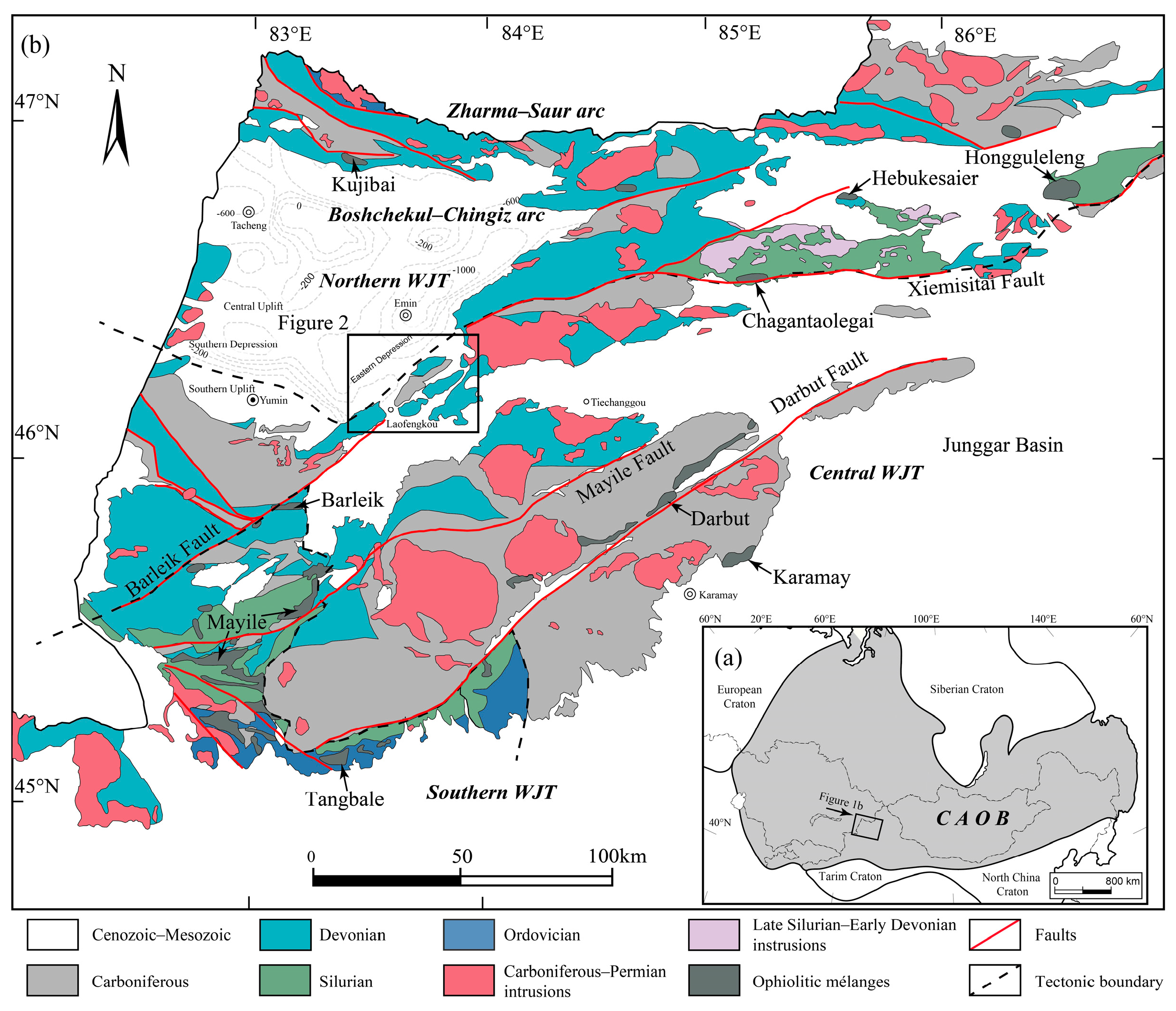
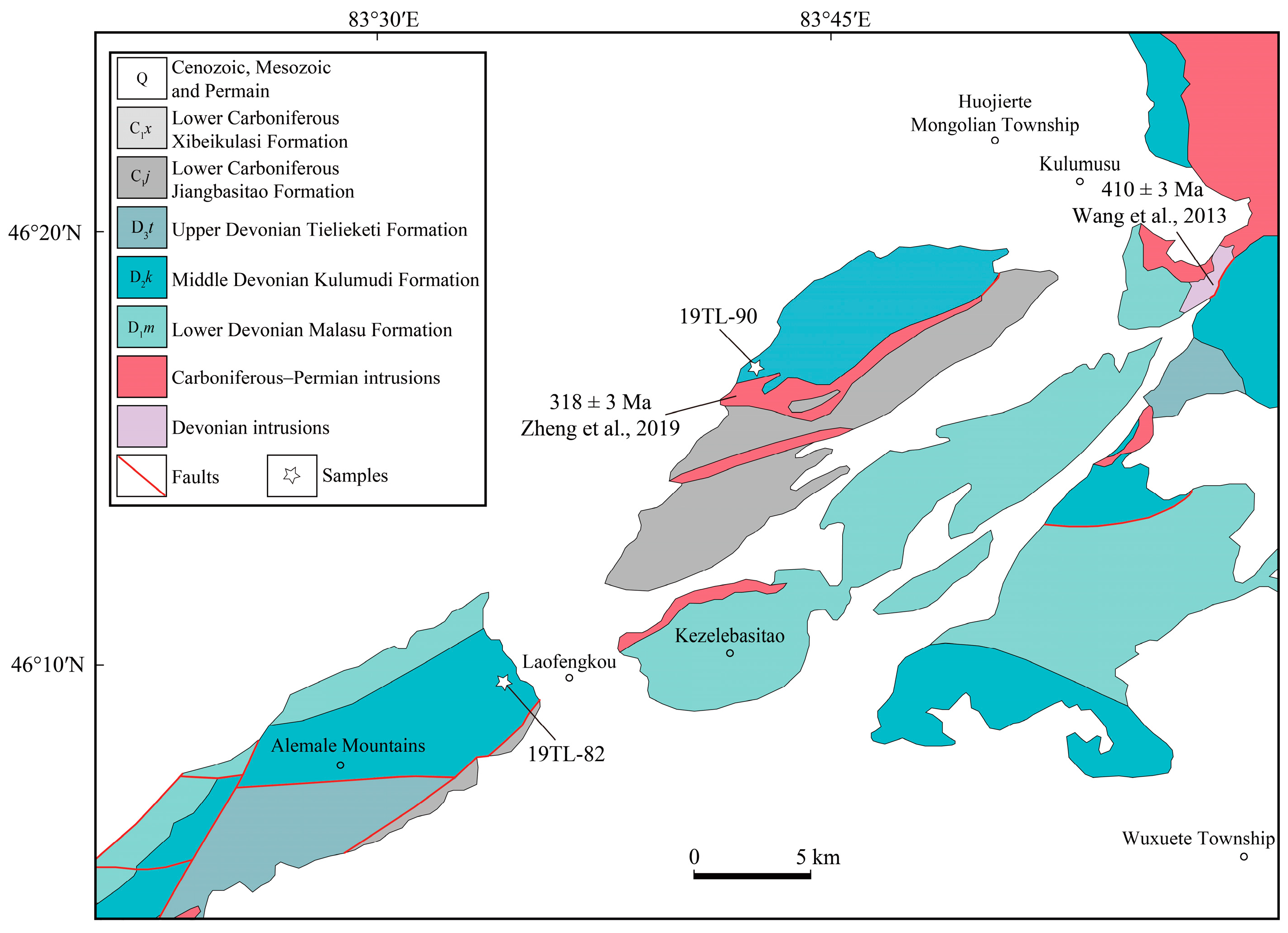


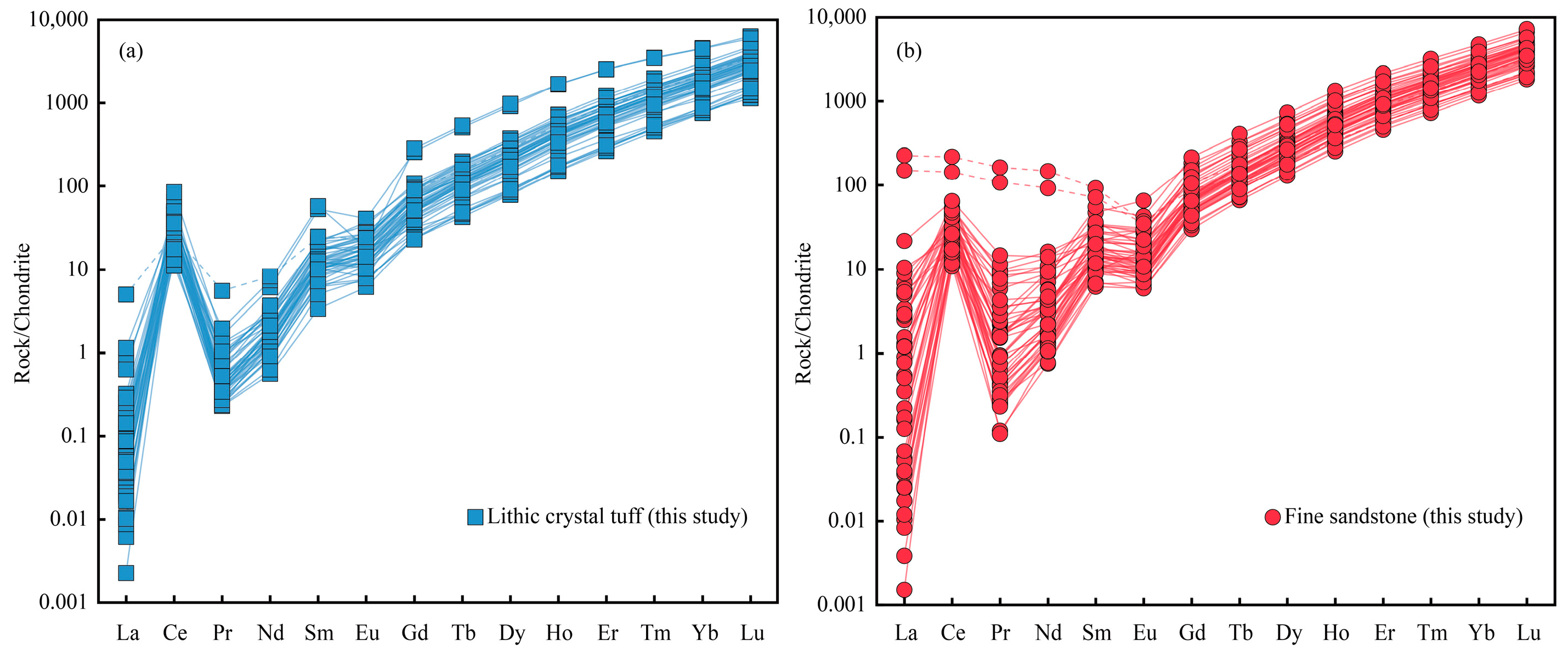

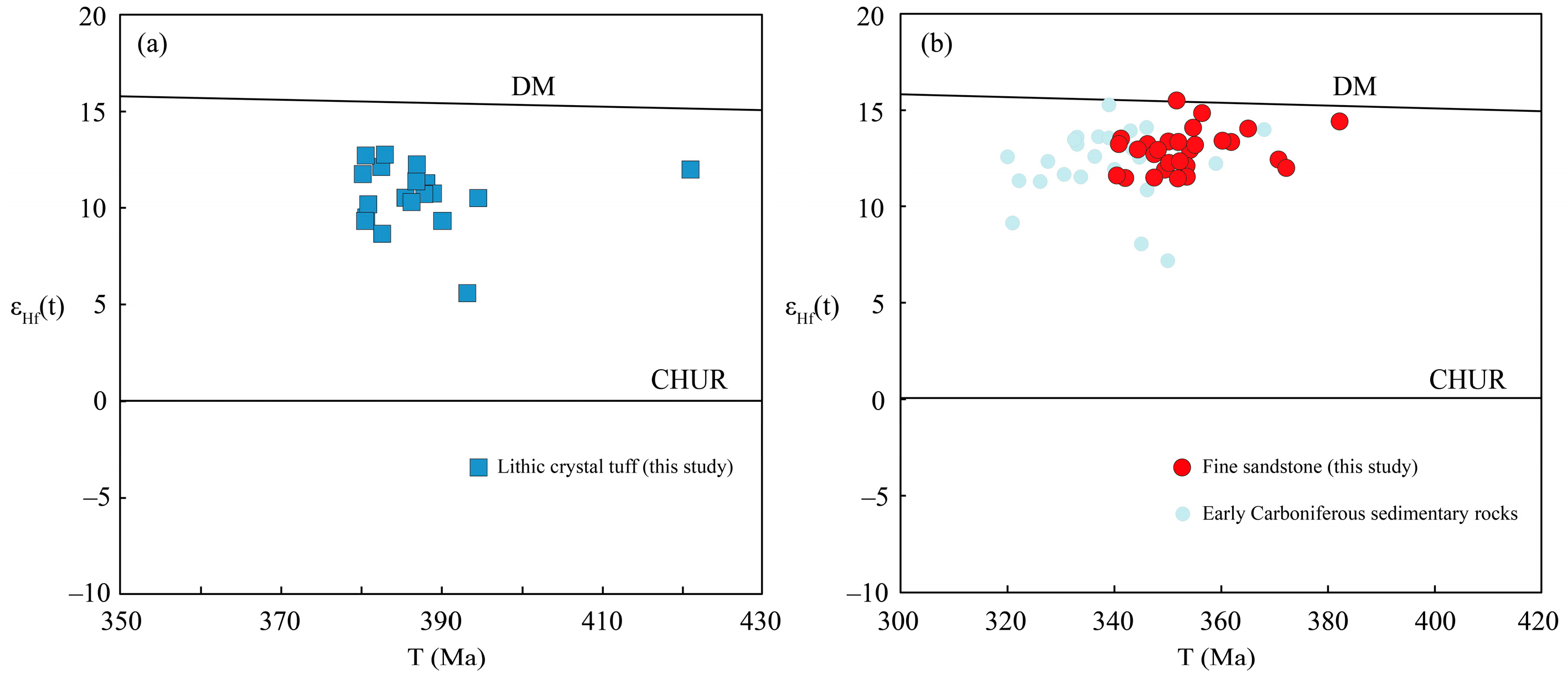

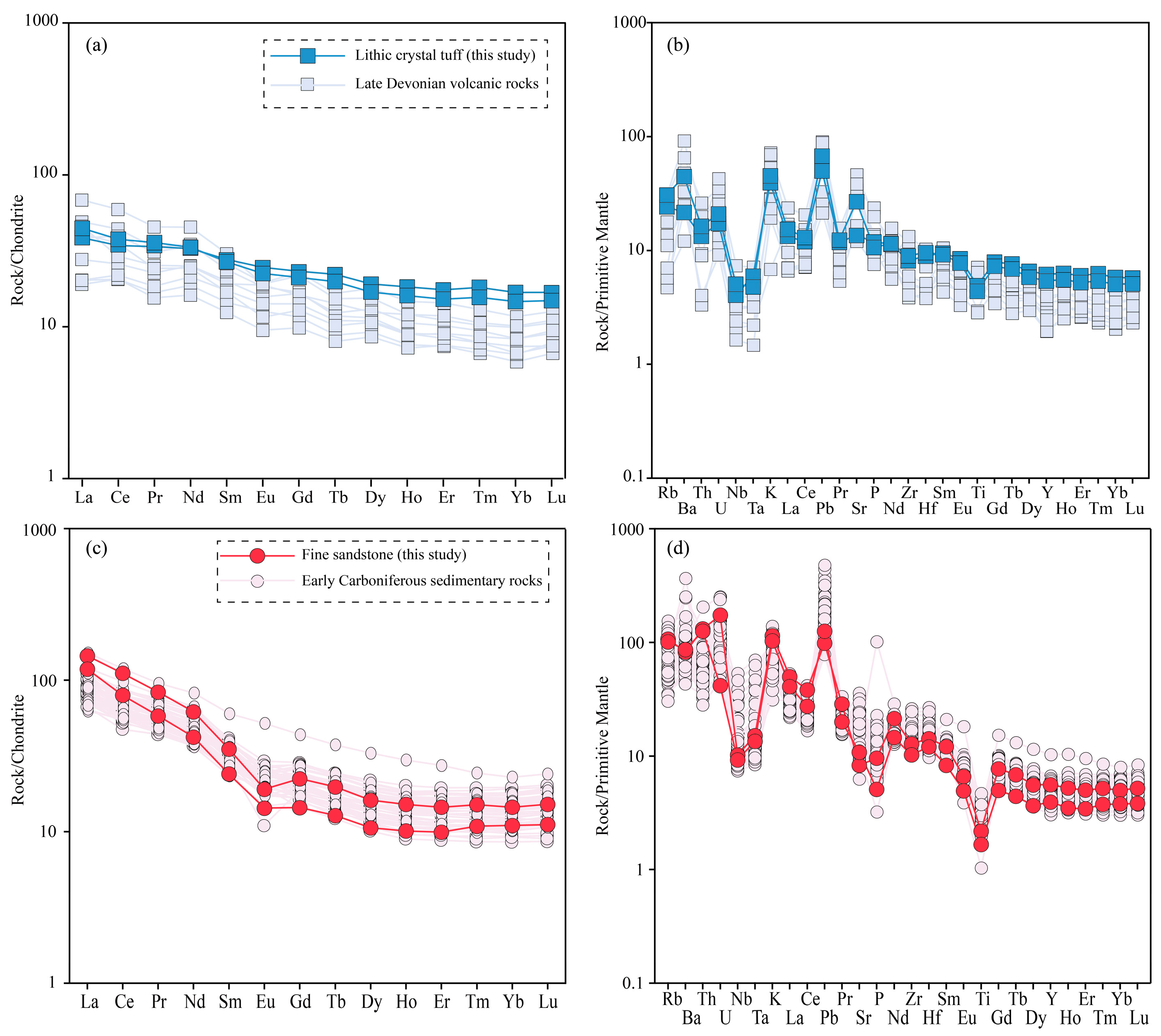
Disclaimer/Publisher’s Note: The statements, opinions and data contained in all publications are solely those of the individual author(s) and contributor(s) and not of MDPI and/or the editor(s). MDPI and/or the editor(s) disclaim responsibility for any injury to people or property resulting from any ideas, methods, instructions or products referred to in the content. |
© 2023 by the authors. Licensee MDPI, Basel, Switzerland. This article is an open access article distributed under the terms and conditions of the Creative Commons Attribution (CC BY) license (https://creativecommons.org/licenses/by/4.0/).
Share and Cite
Liu, B.; Hou, L.-X.; Xu, Y.; Ju, N.; Ma, J.-X.; Xie, Z.-H.; Hong, Y.-B.-H. Zircon U-Pb-Hf Isotopes and Whole-Rock Geochemistry of the “Kulumudi Formation” from the Laofengkou Area (West Junggar): Implications of the Construction of a Juvenile Arc in the Junggar–Balkhash Ocean. Minerals 2024, 14, 14. https://doi.org/10.3390/min14010014
Liu B, Hou L-X, Xu Y, Ju N, Ma J-X, Xie Z-H, Hong Y-B-H. Zircon U-Pb-Hf Isotopes and Whole-Rock Geochemistry of the “Kulumudi Formation” from the Laofengkou Area (West Junggar): Implications of the Construction of a Juvenile Arc in the Junggar–Balkhash Ocean. Minerals. 2024; 14(1):14. https://doi.org/10.3390/min14010014
Chicago/Turabian StyleLiu, Bo, Lin-Xiao Hou, Yan Xu, Nan Ju, Jing-Xuan Ma, Zhi-Hao Xie, and Yang-Bai-He Hong. 2024. "Zircon U-Pb-Hf Isotopes and Whole-Rock Geochemistry of the “Kulumudi Formation” from the Laofengkou Area (West Junggar): Implications of the Construction of a Juvenile Arc in the Junggar–Balkhash Ocean" Minerals 14, no. 1: 14. https://doi.org/10.3390/min14010014





